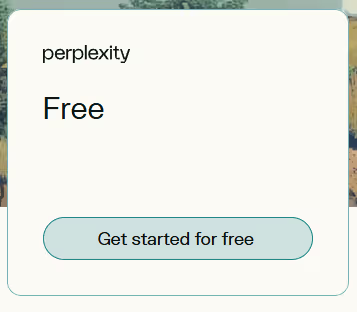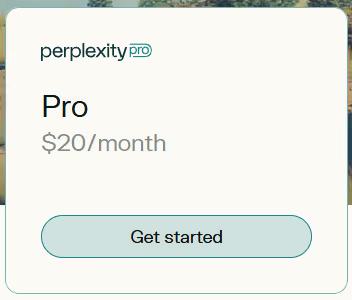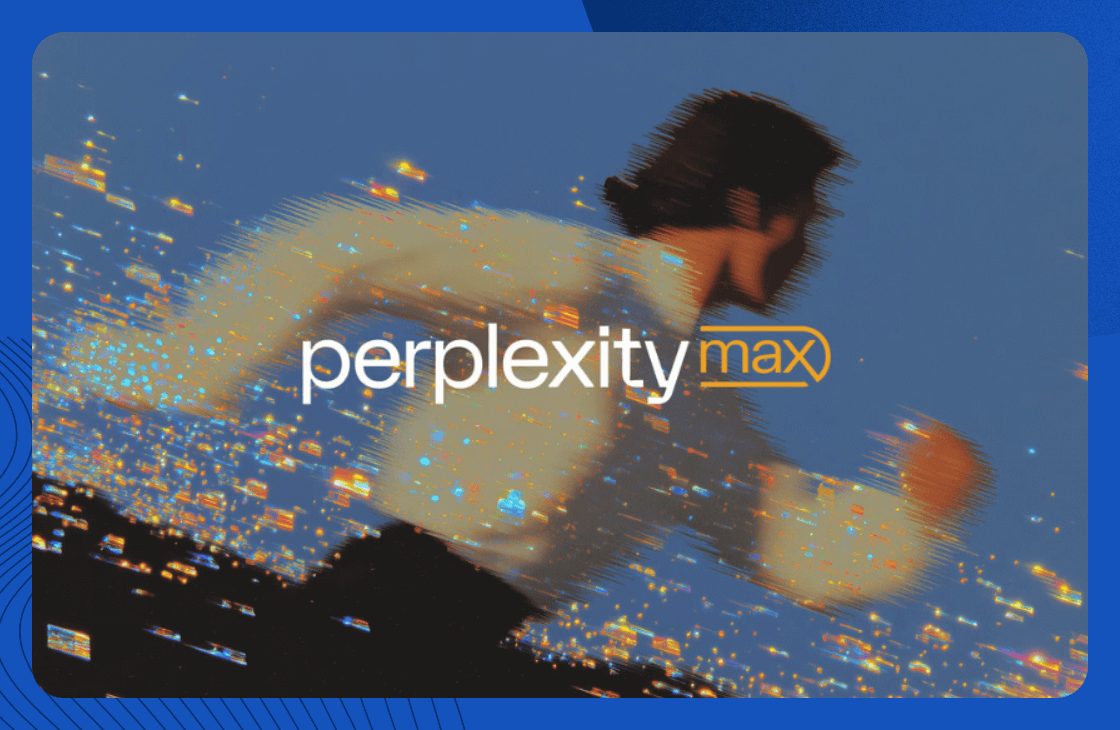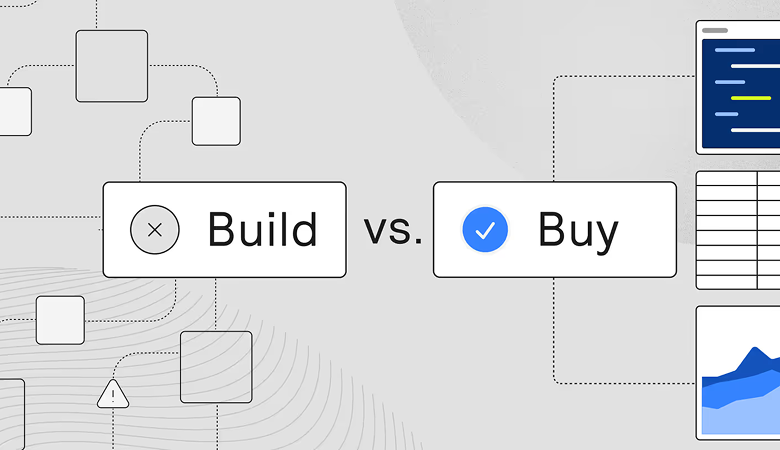Perplexity helps users find answers fast by combining search and generative AI. Behind the scenes, it handles large language model queries, file uploads, image generation, and API interactions. Perplexity monetizes these services through usage-based billing and paid tiers.
The platform offers a free plan and three paid tiers in 2025: Pro, Max, and Enterprise Pro. The Pro plan costs $20/month (or $200/year). Perplexity Max costs $200/month (or $2,000/year). Enterprise Pro costs $40/month per user and includes admin tools and collaboration features.
Each tier gives you higher usage limits and access to premium AI models like GPT-4.1, GPT-4o, Claude 4.0 Sonnet, and new models as they come out.
Note: Prices shown are subject to change at any time. For the most up-to-date pricing, visit Perplexity's official pricing page.
How much does Perplexity cost?
Perplexity Free tier (Standard)

Perplexity Free plan offers unlimited quick searches, limited Pro access, and file uploads at no cost.
Perplexity cost per month: $0
The Free tier lets you run unlimited basic searches and test premium models like GPT-4.1 and Claude 4.0 Sonnet. It’s the easiest way to try the platform with no commitment.
What’s included:
- Unlimited access to Quick Mode for real-time answers using the standard model
- 3 Pro searches per day to test out advanced models like GPT-4
- Ability to upload files and ask questions about them
- Up to 5 follow-up questions every 4 hours
- Saved search history, collections, and access from desktop or mobile
How much is Perplexity Pro?

Perplexity Pro costs $20/month and includes GPT-4 access, higher daily limits, and premium features.
Perplexity Pro price: $20/month or $200/year (includes a $5 API credit each month)
So, what is Perplexity Pro all about? It’s the paid tier designed for high-volume users who need advanced AI tools every day.
What’s included:
- Access to GPT-4.1, Claude 4.0 Sonnet, Mistral, and OpenAI o3-mini
- Unlimited Pro queries and concise searches
- Unlimited uploads for files like PDFs, CSVs, audio, video files, and images. It even includes automatic transcription capabilities.
- AI image generation tools (e.g., DALL·E 3, SDXL)
- “Copilot” interactive assistant mode
- Ad-free experience and faster response times
- Monthly $5 API credit for developers and tinkerers
Perplexity Enterprise Pro (Team)

Enterprise Pro costs $40/month per user or $400/year, with team features and admin controls.
Perplexity AI price per user: $40/month or $400/year (billed per seat)
Enterprise Pro helps teams and companies share access, secure data, and manage admin controls. Perplexity keeps the pricing flat-rate per user instead of usage-based.
What’s included:
- Everything in Pro: GPT-4, Claude, file uploads, Pro search
- Team Spaces for shared files and link-based search
- Centralized admin panel and billing
- SOC 2 Type II compliance and higher data security
- Monthly $5 in API credits per seat
- Priority support for business accounts
How much does Perplexity cost for developers?
Perplexity API pricing starts at $5/month for Pro users, with metered billing beyond that. Perplexity charges for API access based on the model, token count, and usage volume
- API credits: $5/month included with Pro or Enterprise
- Additional usage: Pay-as-you-go based on the model and tokens used
- Pricing ranges from ~$0.002 per request for lightweight models to ~$0.015 per 1K tokens on advanced models
- Track usage directly in your account dashboard
Perplexity API costs are competitive for developers building tools or integrating AI search into products. Perplexity provides a transparent billing system. The included credit covers light usage.
Perplexity Max

Perplexity Max costs $200/monthly or $2,000/annually, designed for individuals who push the platform's limits daily. It’s the top-tier individual plan before you move to Enterprise, unlocking access to the newest AI models and even higher usage limits.
What's included:
- The latest advanced AI models by OpenAI, Anthropic, and more when they release
- No fixed limits on searches per day
- Enhanced Copilot features with deeper context understanding
- Priority API and faster in-app response times
- All Pro features: File uploads, AI image generation, unlimited follow-ups
Key elements of Perplexity's usage-based pricing approach
In‑app usage is predictable (daily caps reset on schedule). API usage scales with volume once you pass the monthly credit. Key points:
- $5 monthly API credit per Pro/Max/Enterprise Pro seat.
- Beyond the credit, charges reflect request count, tokens, and chosen model.
- No in‑app overage fees: When you hit daily limits, usage pauses until reset. The API continues to bill based on use.
Remember: Pricing, plans, and features are subject to change. For the most up-to-date information, always refer to Perplexity’s official pricing page.
Why is usage‑based billing becoming the default?
AI and infrastructure workloads vary minute to minute. Fixed seat pricing doesn’t reflect compute spikes, token bursts, or agent activity. Usage‑based models align price with value and keep pricing fair for light and heavy users alike.
For product teams, usage metering and simulation support faster pricing iteration without rebuilds. For finance, guardrails like threshold billing and prepaid credits help protect margins as adoption grows.
For customers, you pay for what you actually use. That matters when model choice, context length, and retrieval steps change the cost per query.
Learn more: For a full breakdown of how AI companies are pricing agents in production, download our guide on pricing AI agents. If you’d rather get hands-on, check out our step-by-step tutorial on implementing agent pricing yourself.
Why do companies like Perplexity adopt usage-based billing?
Perplexity uses usage-based billing (for things like API calls and extra-generative queries) to better align price with value. Why are more companies doing this?
- Costs fluctuate with usage: Every answer Perplexity generates incurs compute costs. Heavy users create higher expenses, while light users cost less.
A flat-rate plan would either undercharge power users or overcharge casual ones, whereas usage-based charges ensure each customer pays roughly for what they consume. This model is more sustainable for the business.
- Value isn’t tied to seat count: Traditional software pricing often charged per user seat, but with AI services like Perplexity, one person might send hundreds of queries while another asks just a few.
Usage reflects the actual value received. By billing based on queries, tokens, or credits, Perplexity’s pricing scales with how much someone actually uses the product, ensuring high-use customers get charged more and low-use customers can pay less.
- Usage spikes are unpredictable: Perplexity usage can vary. Usage-based billing handles these spikes gracefully, charging for the surge in queries without requiring the user to upgrade to a higher fixed plan beforehand.
Users don’t have to commit to an expensive plan, and Perplexity still captures revenue when usage surges. It’s a win-win that prevents surprises. Users see the direct correlation between their heavy usage and the bill, rather than hitting an arbitrary limit.
How Perplexity built a modern billing system
Rather than divert engineering resources to reinvent this wheel, Perplexity chose to integrate Orb’s billing platform to power its usage-based pricing infrastructure. Orb specializes in flexible, usage-driven billing, and it now underpins Perplexity’s payments and subscriptions.
Perplexity adopted Orb early in its paid offerings (Orb even publicly welcomed Perplexity as a customer in 2023). This meant that from the start, Perplexity could roll out new pricing models quickly without building everything from scratch.
Orb lets Perplexity adjust pricing or packaging without extensive re-engineering. As Perplexity’s product evolves (say, adding a new feature like Labs or an entirely new plan like Max), the billing logic can evolve in tandem by configuring new metrics or pricing rules in Orb.
FAQs
Is the Perplexity API free?
The Perplexity API isn’t free. It includes $5 of API credit in paid plans. After that, it measures usage and bills based on requests and tokens.
Do you have to pay for Perplexity?
You do not have to pay for the free version of Perplexity. Still, the free plan limits you to a restricted number of Pro searches per day and only a few follow-up questions. Paid plans give you GPT-4.1, Claude 4.0 Sonnet, image generation, and higher usage limits.
How much does the Perplexity app cost?
Perplexity Pro costs $20/month or $200/year, while the Enterprise plan is $40/user/month. The free version remains available with some limited advanced features. API usage adds extra charges on top of subscriptions.
Can Perplexity generate images?
Yes, Perplexity can generate images using models like DALL·E 3 and Stable Diffusion, but this feature is only available on paid Pro and Enterprise plans. Free users do not have access to image generation.
Power usage-based billing models with Orb
Perplexity pairs predictable subscriptions (Free, Pro, Max, Enterprise Pro) with metered API credits. Many AI tools now use the same hybrid approach: Flat‑rate tiers for the UI plus usage‑based components for programmatic access or high‑variability workloads.
If you’re designing pricing for an AI product, start with clear plan entitlements, then meter the events that actually drive cost and value (tokens, requests, retrieval steps, documents processed).
Orb is the done-for-you billing platform that helps SaaS and GenAI companies launch and evolve pricing models backed by real usage data, without depending on rigid systems or custom engineering work. Here’s how Orb helps:
- Launch prepaid credit systems: With Orb, you can replicate this logic by assigning prepaid usage allowances, rolling over unused credits, and tracking consumption in real time, all without hardcoding any of it.
- Meter API usage and track spend: Orb gives you full control to meter any usage event and convert it into billable metrics. You define how overages work.
- Customize plans with tiers, usage caps, and billing logic: Want to set plan-specific usage thresholds? Orb supports dynamic rules for usage limits, allowances, and caps.
- Tailor pricing logic to real user behavior: Use Orb SQL Editor to define your own metrics, whether that's tokens, requests, or documents analyzed. Then translate those definitions directly into monetizable pricing rules.
- Run side-by-side pricing tests: With Orb Simulations, you can test different pricing strategies using real historical usage data before you roll them out. See how each option would affect revenue, churn, or adoption in a live environment without the risk.
- Launch without involving engineers: Teams can use Orb’s easy-to-use tools to create, update, and deploy pricing plans, all without engineering. Business leads can experiment and iterate without triggering dev cycles.
- Send clear, accurate invoices every time: Orb’s transparent invoicing gives your customers a detailed view of usage and charges, backed by a complete audit trail for every event and calculation.
- Roll out new pricing safely: Use version control for plans, deploy updates gradually, and control rollout rules. Whether you're launching a new Pro tier or phasing in overage pricing, you can manage it without breaking customer trust.
From usage caps to prepaid models to event-based metering, Orb supports the logic behind every modern pricing framework. Explore Orb’s flexible pricing tiers to start building a monetization system that evolves with your product.



